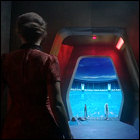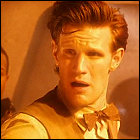 The Doctor tries to show Clara some of the basics of TARDIS operation, but as she makes her first attempt to fly the timeship, it’s scooped up violently by a space salvage vessel and is severely damaged. The Doctor emerges from the wreckage aboard the salvage ship and meets the van Baalen brothers, who own the ship and plan to dismantle the TARDIS. The Doctor tries to make an even better deal with them – if they can help him find Clara, they can have the TARDIS. The van Baalens are wary of the deal, leaving the Doctor with little choice but to set the TARDIS to self-destruct. Now the brothers half 30 minutes to help the Doctor find Clara… and maybe they’ll still have time to escape with their lives. But the search is complicated by distorted humanoid figures stalking the TARDIS corridors, beings whose presence even the Doctor can’t readily explain. Finding Clara won’t be easy, since she’s already hiding from these creatures – creatures whose origins are closely tied to every living being currently inside the TARDIS.
The Doctor tries to show Clara some of the basics of TARDIS operation, but as she makes her first attempt to fly the timeship, it’s scooped up violently by a space salvage vessel and is severely damaged. The Doctor emerges from the wreckage aboard the salvage ship and meets the van Baalen brothers, who own the ship and plan to dismantle the TARDIS. The Doctor tries to make an even better deal with them – if they can help him find Clara, they can have the TARDIS. The van Baalens are wary of the deal, leaving the Doctor with little choice but to set the TARDIS to self-destruct. Now the brothers half 30 minutes to help the Doctor find Clara… and maybe they’ll still have time to escape with their lives. But the search is complicated by distorted humanoid figures stalking the TARDIS corridors, beings whose presence even the Doctor can’t readily explain. Finding Clara won’t be easy, since she’s already hiding from these creatures – creatures whose origins are closely tied to every living being currently inside the TARDIS.
written by Steve Thompson
directed by Mat King
music by Murray Gold
Cast: Matt Smith (The Doctor), Jenna-Louise Coleman (Clara), Ashley Walters (Gregor van Baalen), Mark Oliver (Bram van Baalen), Jahvel Hall (Tricky), Sarah Louise Madison (Time Zombie), Ruari Mears (Time Zombie), Paul Kasey (Time Zombie)
Notes: This is the first mention of the Eye of Harmony in the revived series, last mentioned in the 1996 TV movie starring Paul McGann and originated in the 1976 Tom Baker story The Deadly Assassin, where access to the Eye occurred through a heavily protected obelisk. The McGann movie introduced the concept that each TARDIS contained an “aspect” of the Eye, and this episode matches up very well with that addition to the mythos.
Given that the Eye is depicted here as a floating ball of energy, in effect a miniature star, it could be inferred that the Eye was located just beneath the floor-mounted hemispherical vault doors sen in the McGann movie’s TARDIS cloister room. This is the first time that new TARDIS interior sets beyond mere corridors have been constructed for Doctor Who as an ongoing series since the Peter Davison era.
LogBook entry & review by Earl Green
Review: We Doctor Who fans are an excitable bunch sometimes. Tell us we’re going to get to see more of the TARDIS interior than we’ve seen since the ’80s, and even kids who weren’t even alive in the ’80s get positively verklempt over the idea. A story that takes place mostly in the TARDIS is a knife’s-edge notion in Doctor Who. You’re going to get brilliance  (The Edge Of Destruction, 1964), or you’re going to limit the scope of a story that could’ve taken place almost anywhere because the TARDIS sets are too expensive not to shoot in (Doctor Who, 1996), or you’re going to get raked over the coals because the TARDIS isn’t what the fans thought it would look like (The Invasion Of Time, 1978). This probably has a lot to do with why we haven’t seen much of the TARDIS’ innards in the new series: someone’s bound to find it a letdown. It’s almost better to talk about it having a swimming pool and a library and a garage and a room full of grass and butterflies and sunshine than to show these things.
(The Edge Of Destruction, 1964), or you’re going to limit the scope of a story that could’ve taken place almost anywhere because the TARDIS sets are too expensive not to shoot in (Doctor Who, 1996), or you’re going to get raked over the coals because the TARDIS isn’t what the fans thought it would look like (The Invasion Of Time, 1978). This probably has a lot to do with why we haven’t seen much of the TARDIS’ innards in the new series: someone’s bound to find it a letdown. It’s almost better to talk about it having a swimming pool and a library and a garage and a room full of grass and butterflies and sunshine than to show these things.
While Journey has an intriguing premise, it’s got quite a few distractions too: the feud between the brothers, the big reveal of a book chronicling the history of the Time War (a book that could  really only exist in the Doctor’s TARDIS, for surely he is the only person who could write that history since he is the only combatant to survive), and in the end, really, even the humanoids chasing the Doctor and friends through the TARDIS are a red herring, wiped out by a jump back in time to erase the whole problem. It doesn’t seem like it’s much of a coincidence that the last mention of the Eye of Harmony happened in the 1996 Paul McGann movie, since it used a similar trick to undo the catastrophic damage done in its own storyline. In the end, Journey To The Centre Of The TARDIS winds up not having happened at all, and lacks the sheer charm possessed by the new series’ sole previous adventure within the TARDIS, The Doctor’s Wife.
really only exist in the Doctor’s TARDIS, for surely he is the only person who could write that history since he is the only combatant to survive), and in the end, really, even the humanoids chasing the Doctor and friends through the TARDIS are a red herring, wiped out by a jump back in time to erase the whole problem. It doesn’t seem like it’s much of a coincidence that the last mention of the Eye of Harmony happened in the 1996 Paul McGann movie, since it used a similar trick to undo the catastrophic damage done in its own storyline. In the end, Journey To The Centre Of The TARDIS winds up not having happened at all, and lacks the sheer charm possessed by the new series’ sole previous adventure within the TARDIS, The Doctor’s Wife.
Naturally, the danger with a story that never happened at all is that you may have an audience scratching their head, wondering why they watched it at all. The irresistible hook is that this is where the beans are spilled and the Doctor tells Clara about his past and future encounters with her and her multiple deaths. But with even  that short circuited by the end of the story, it ends up being a harmless romp – truthfully, no better and no worse than The Invasion Of Time in that regard.
that short circuited by the end of the story, it ends up being a harmless romp – truthfully, no better and no worse than The Invasion Of Time in that regard.
There’s a running thread about waiting too long to be honest – whether it’s the Doctor never having gotten around to telling Clara why he sought her out as his companion, or the brothers conspiring to convince one of their own that he’s an android, only to watch as he finds out for himself – almost fatally – that he isn’t. Sure, if honesty is the running theme of the story, the story could be honest enough to have some of these plot developments stick. I have similar feelings where other “oh, this never happened” stories are concerned in other series – Star Trek used this gag repeatedly (TNG: Yesterday’s Enterprise, Future Imperfect, All Good Things…, DS9: The Search,  Voyager: Deadlock, The Year Of Hell, Enterprise: E2 …to name just a few), but Star Trek usually had at least 20 episodes per season and could just about get away with burning off one of those episodes with a cheap storytelling parlor trick. With a series that has only 13 or 14 episodes per season – and let’s not forget that it took two years to see all of those episodes – it feels like more of a wasted opportunity at best, and a waste of 1/14th of an already-spread-too-thin season at worst.
Voyager: Deadlock, The Year Of Hell, Enterprise: E2 …to name just a few), but Star Trek usually had at least 20 episodes per season and could just about get away with burning off one of those episodes with a cheap storytelling parlor trick. With a series that has only 13 or 14 episodes per season – and let’s not forget that it took two years to see all of those episodes – it feels like more of a wasted opportunity at best, and a waste of 1/14th of an already-spread-too-thin season at worst.
